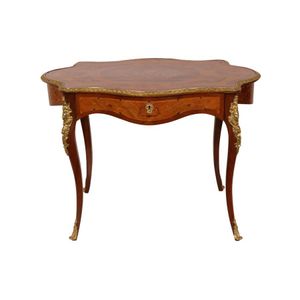French Walnut Marquetry Bureau Plat with Gilt Mounts
You must be a subscriber, and be logged in to view price and dealer details.
Subscribe Now to view actual auction price for this item
When you subscribe, you have the option of setting the currency in which to display prices to $Au, $US, $NZ or Stg.
- Marquetry - In marquetry inlay, contrasting woods, and other materials such as ivory, shell and metal are inlaid either as panels or in a single continuous sheet over the surface of the piece. The design may be straightforward, such as a shell pattern or a basket of flowers, or it may be infinitely complex, with swirling tendrils of leaves, flowers and foliage, such as one finds, for example, in the "seaweed" patterns on longcase clocks of the William and Mary and Queen Anne periods.
- Apron - A decorative wooden panel that sits underneath the top surface of a table or chair, and unites the top of the piece with the legs, running at right angles to the underside. On carcase furniture such as a chest or wardrobe, the apron sits below the drawers or doors and attaches to the legs.
On carcase furniture without legs the panel under the drawers or doors sits on the floor and is termed a plinth.
An apron can provide a decorative touch to an otherwise unadorned piece of furniture and at the same time provide structural support and strength. They can be carved or pierced and quite elaborate. - Frieze - An architectural term denoting the flat, shaped or convex horizontal surface of furniture, between the architrave and the cornice, usually found on a cabinet or bookcase, or on desks and tables where it may include drawers, the area between the top and the legs. In ceramics, the term refers to the banding, of usually a repeating pattern, on the rims of plates and vases.
- Serpentine - Resembling a serpent, in the form of an elongated 'S'. A serpentine front is similar to a bow front, except that the curve is shallow at each end, swelling towards the middle. The term presumably derives from its similarity to a moving snake or serpent. Serpentine fronts are usually veneered, with the carcase either being cut and shaped from a solid piece of timber, or built in the 'brick' method.
- Cabriole Leg - The cabriole leg evolved from an elongated scroll, curving out at the knee which may or may not be carved, and forming a serpentine shape as it descends to the foot.
First introduced into English furniture in the late 17th century, cabriole legs were widely used during the Queen Anne and early Georgian periods, where they frequently terminated in a pad foot or ball and claw foot. The style has had many imitators since then. The cabriole leg was re-introduced in the mid-19th century, and is commonly associated with the balloon-back dining or drawing-room chairs made in walnut, mahogany or, in Australia, cedar. The Victorian cabriole leg, on the whole, was rather more slender than the earlier form, following the French style, which emphasized the delicacy and daintiness of the chairs they were designed to support. Cabriole legs are sometimes found on windsor chairs, especially those made during the 18th century. - Foliate - Decorated with leaves or leaf-like forms.
- Panels - Timber pieces, usually of well-figured wood either recessed or applied over the frames of doors and as decoration elsewhere in the carcase of cabinet furniture. The panels may take a variety of shapes rectangular, square, shield shape, oval, half-round or in the form of Egyptian pylons.
- Mounts - Mounts are used to describe bronze, brass and ormolu adornments on furniture especially quality furniture in the rococo and classical revival style, and are also the cabinet makers' name for the metal fittings on furniture, such as hinges, locks and handles, and metal edges and guards which protect furniture from damage.
This item has been included into following indexes:
Visually similar items

A Louis XV style gilt metal mounted marquetry inlaid side table, serpentine, with foliate inlaid panels above cabriole legs, 90 x 66 x 61 cm.

French parlour table, late 19th century walnut with brass banding and mounts kingwood and satinwood inlaid decorations

A flame veneered mahogany bureau plat, French 19th century

A kingwood bureau plat with tooled tan leather insert and sliding panels at either end supported on ormolu mounted serpentine legs, French, 20th century, 76 cm high, 140 cm wide, 79 cm deep (not extended)
